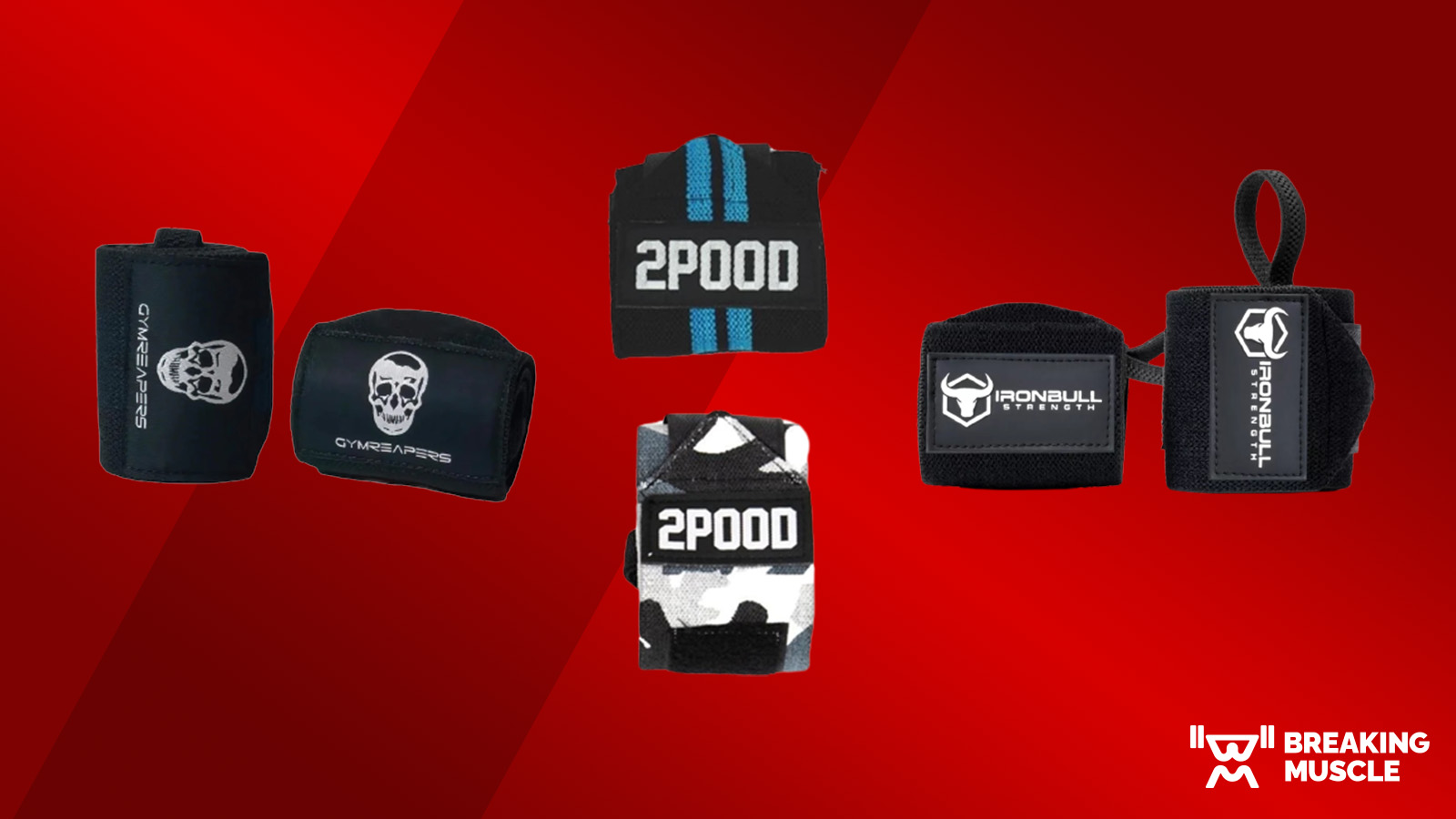
If you want to improve your performance and protect your wrists from injury, you should consider investing in a pair of wrist wraps. Wrist wraps are a type of support gear that wraps around your wrists to provide extra stability and support. The best wrist wraps can even help you lift heavier weights and improve your technique!
But not all wrist wraps are created equal. Depending on your goals, preferences, and type of training, you’ll need a different style of wrist wrap. Some wraps are longer and stiffer, while others are shorter and more comfortable. Whether you’re into bodybuilding, powerlifting, weightlifting, or CrossFit, you’ll find the ideal pair of wrist wraps on this list for you.
How We Chose the Best Wrist Wraps
We’re a diverse team of certified fitness experts, exercise enthusiasts, and knowledgeable product testers. We have dozens of years of combined experience using wrist wraps for various activities and sports, and we tried out more than a dozen different pairs of wrist wraps specifically for this guide.
To help you choose the best wrist wraps for your needs, we’ve compiled a list of the eight top-rated wrist wraps on the market. We’ve reviewed their features, benefits, pros, and cons and compared them. During testing, we judged wrist wraps on their materials and construction, length and stiffness, closure mechanism, price, and more — rating each wrist wrap with a score between 1 to 5.
Our Top Picks for the Best Wrist Wraps
Best Wrist Wraps Overall: Iron Bull Strength Classic Wrist Wraps
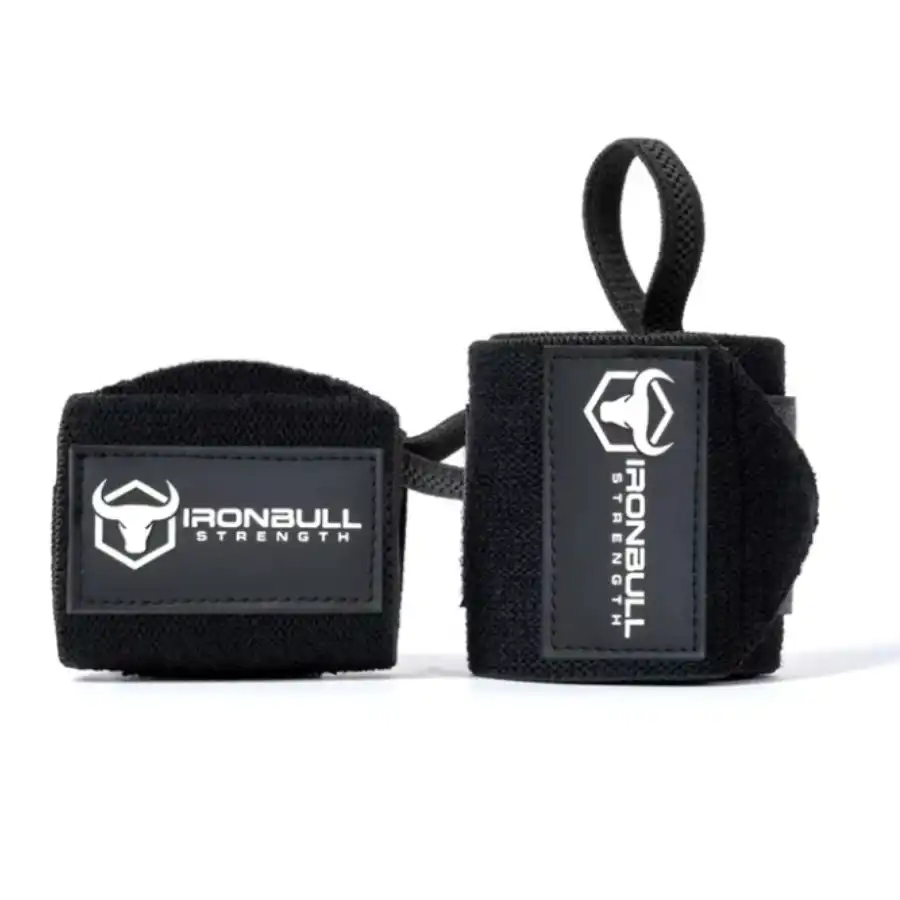
Pros
- Comfortable and solid wrist support
- Easy-to-use Velcro closure system
- Multi-purpose design
- 30-day money-back guarantee
- Ten colors available
Cons
- 18-inch length might be too short for some
- Not IPF-approved
The Iron Bull Strength Classic Wrist Wraps offer great wrist support. They’re 18 inches long, which gives you at least two wraps around your wrist if you have an average build. I find the 18-inch length to be just right; it’s not so long that there’s a ton of bulk on my wrists due to the extra material, and their support is adequate for most weight training exercises.
Their three-inch width provides plenty of wrist coverage, covering enough of the base of your hand and wrist area for the wrap to do its job. Also, the cotton-elastic blend gives enough stretch for solid compression and wrist support in your workouts. I especially like the blended material of these wraps — they’re soft, and the cotton breathes enough to help avoid excess sweating in the first place.
Moreover, the Velcro closure system of the Classic Wrist Wraps is intuitive and easy to use. The thumb loop offers an excellent anchor point to help put them on tightly, and, unlike other brands, the double-stitching is high quality. I especially like how the Velcro section is sticky and well-sized. Some brands use such a long strip that can cause the extra material to hang off the end, which can get caught on things and unravel your wraps. Plus, the thumb loop makes it easy to hang over a hook to dry between workouts.
One of my favorite features of the Iron Bull wraps is their multi-functionality. They’re suitable for various training styles, from bodybuilding and Olympic weightlifting to CrossFit and powerlifting. Their 18-inch length and cotton-elastic blend make them lightweight on your wrists for the dynamic workouts of CrossFit and supportive enough for heavier powerlifting. This means that you can continue using them when you want to switch up your training styles without having to buy a different pair of wrist wraps.
Unfortunately, the Iron Bulls aren’t perfect. The 18-inch length is a solid general length, but most people with average wrists will only be able to get two revolutions of the wraps around their wrists. This means you’ll have less support on heavier lifts, which might be noticeable if you’re at an advanced level in powerlifting.
On that note, these wrist wraps are USPA, IPL, IWF, and USAW-approved… but they aren’t approved for use in the International Powerlifting Federation (IPF). Suppose you’re a competitive powerlifter or aspire to compete in the highest level of powerlifting in the future and want to use wrist wraps in competition. In that case, this means you’d have to buy a separate pair that’s approved for IPF use — you might want to consider the SBD Wrist Wraps instead if that applies to you.
All the above considered, we rank these 4.5 out of 5 stars for their great wrist support, easy-to-use Velcro closure system, and multi-functionality for different training styles.
RELATED: Best Home Gym Equipment Essentials for Cardio, Strength Training, and More
Best Wrist Wraps for Powerlifting: SBD Wrist Wraps
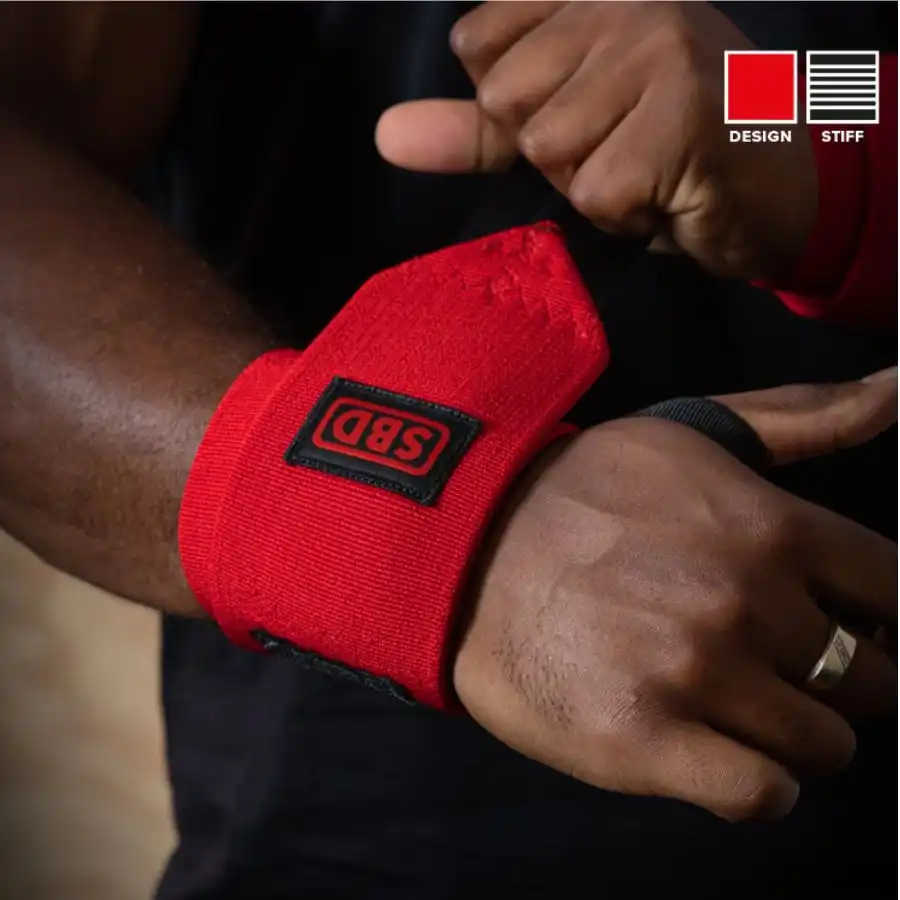
SBD Wrist Wraps
4.5
- Material: 70% polyester/30% rubber (flexible), 56% rubber/44% polyester (stiff)
- Length: 15.7 inches (S), 23.6 inches (M), or 39.4 inches (L)
- Closure type: Velcro
- IPF-approved: Yes
Check Price
Pros
- Approved for IPF and USPA use
- Excellent build and durability for powerlifting
- Various lengths and stiffnesses available
- Manufactured in Great Britain
- SBD brand is world-renowned in strength sports
Cons
- Might be uncomfortable for some
- More expensive
The standout feature of the SBD Wrist Wraps is that they’re IPF-approved. Investing in a pair of wrist wraps that you can practice with allows you to push your training harder, so you can (hopefully) get even stronger while getting comfortable using them before a competition. This way, you’ll step on the platform confidently in your support wear — letting you focus entirely on executing your attempts instead of worrying about your gear and how it’s fitting.
If you live and breathe powerlifting, these wrist wraps will not disappoint. They’re designed specifically for excellent wrist support; the thumb loop is heavy-duty and attached along industrial-grade fastening. But they didn’t stop there.
SBD crafted them to match the maximum allowable width of 8 centimeters/3.15 inches, so you’ll get the best coverage between your hand and wrist for a solid cast-like level of support. They even have proprietary wide elastics in these wraps. One customer who bought the stiff mediums said they took a few times to break in, but after that, they give you the best protection from heavy weights. I’m seriously impressed and confident that whether you’re pushing new bench press PRs or back squat records, these wraps will help you hit them safely.
What surprised me the most about the SBDs is their range of lengths and stiffnesses. On their product page, they have three different lengths available: small (15.7 inches long), medium (23.6 inches long), or large (39.4 inches long). Combined with their detailed sizing chart, this means that whether you have small, average, or large wrists, you can find a wrist wrap length that will work great for you.
Their two stiffness options, flexible or stiff, are built with varying amounts of polyester and rubber (elastic). For example, the flexible wraps have a 70% polyester-30% rubber blend that allows some wrist flexion and improved comfort due to the higher amount of polyester. The stiff wraps are woven with significantly more rubber, giving them more stretch and compression to fully immobilize your wrists. SBD mentions that most athletes will prefer the medium-length flexible wraps, but use their size guide to determine the ideal length for you.
These wrist wraps might be uncomfortable, especially if you choose their “stiff” option. One reviewer mentioned that their large-sized stiff wraps are excellent but can get really tight and start to cut off blood circulation to their wrists.
When I didn’t see the material specs on their product page, a Breaking Muscle staff member reached out through their live chat and discovered that the stiff wrist wraps are 56 percent rubber (elastic) and 44 percent polyester blend. With over half the wraps’ material being elastic and zero cotton included, it’s no surprise these can be a tad uncomfortable.
It should come as no surprise that excellent quality comes at a price. At the time of writing, the SBDs retailed for $42.50. This makes them the most expensive wrist wraps out of all those featured in this article and possibly out of the budget of financially constrained lifters.
All the above considered, we rank these 4.5 out of 5 stars for their IPF approval, excellent build quality and durability, and various length and stiffness options available.
Best Wrist Wraps for Weightlifting: DMOOSE Wrist Wraps
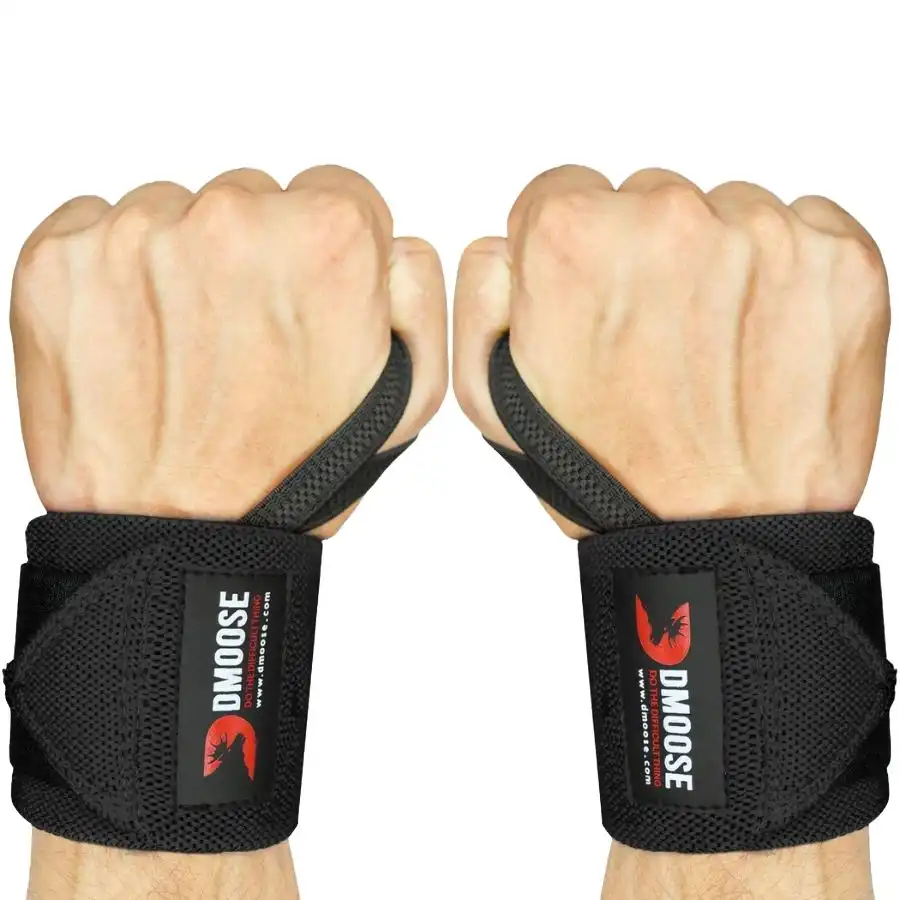
Pros
- Quality construction for Oly lifting
- Flexible material allows for wrist mobility
- Two lengths available
- 30-day money-back guarantee
- 12 color options
Cons
- 12 inches is too short for average wrists
- Not approved for weightlifting federations
Despite their affordable price, the DMOOSE Wrist wraps have a solid quality construction. The thumb loop features double stitching, so it will stand up to the rigorous Olympic lifts you’ll be performing with them. I found the Velcro fastening strip to be of good quality, so it won’t wear down within a couple of months as the poor-quality wrist wraps do.
These wrist wraps from DMOOSE are the best for weightlifting because, unlike other wrist wraps featured in this article, these have no polyester included. When woven with elastic, cotton is more flexible compared to polyester, and this pays off big time for the Olympic lifts.
This lack of restriction allows you enough wrist mobility for your wrists to rotate freely in the snatch and to extend fully in the front rack portion of the clean and jerk. Despite its flexibility, the cotton-elastic blend still gives noticeable wrist support when the bar is extended overhead in the final step of both exercises.
I appreciate that these wrist wraps are offered in a 12-inch and an 18-inch option. The latter will fit and work well for average-sized wrists, but the former is still useful. Even though they’ll outgrow them, 12-inch long wrist wraps would be the ideal length for most teenagers because their bones are still growing, and the wrist wrap length they need is significantly smaller than that of the average adult.
However, you might also find the 12-inch length useful if you are petite and/or have extremely small wrists – make sure to use the sizing chart before ordering a 12-inch size just to be sure it’s the right fit.
Although the 12-inch length is an option, I wouldn’t recommend it if you have average-sized wrists. 12 inches won’t give you enough length on the wraps to get an adequate number of revolutions for the wraps to provide significant support.
Sadly, it doesn’t look like these wrist wraps are approved for any weightlifting federations. This means that if you want to wear wrist wraps in a future weightlifting competition, you’ll have to invest in a separate pair to use them in both your training and your competitions.
All the above considered, we rank these 4 out of 5 stars for their Olympic lifting-friendly design, two length options, and comfortable material.
Best Wrist Wraps for CrossFit: 2POOD Wrist Wraps
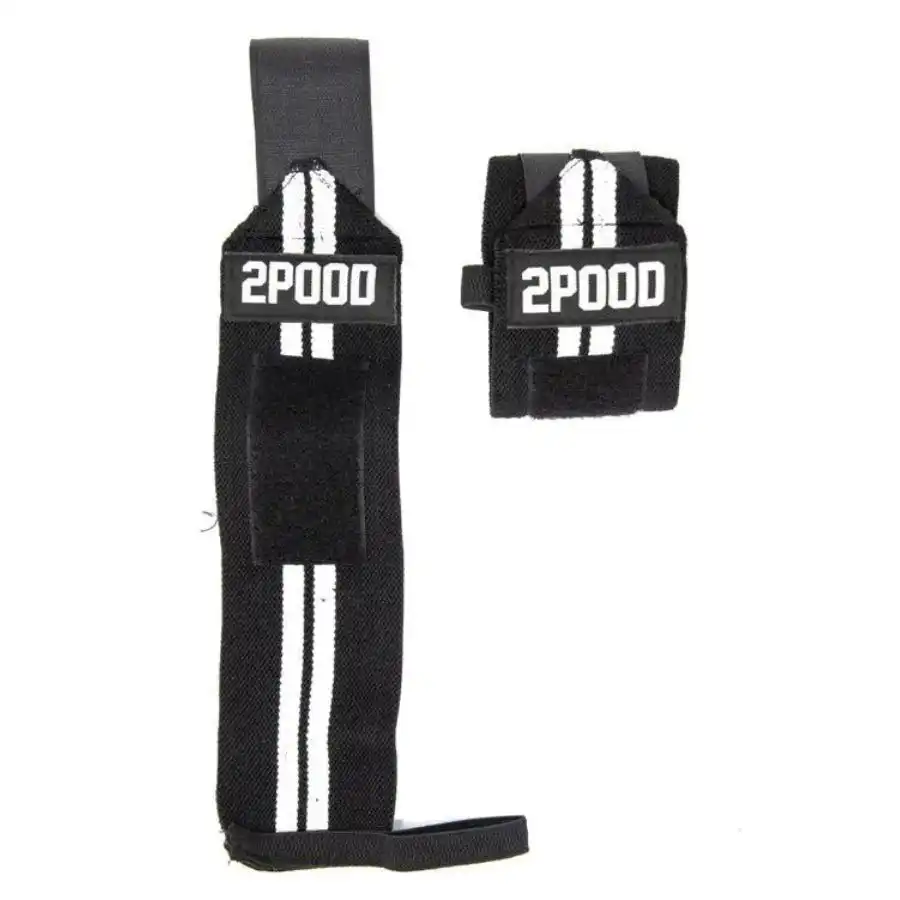
Pros
- Lightweight and supportive for long CrossFit workouts
- Hook and loop closure is secure, easy-adjusting
- Official wrist wraps of the NOBULL CrossFit Games
Cons
- Some reports of poor Velcro
- Not IPF-approved
These are the best wrist wraps for CrossFit due to their lightweight, supportive design. Out of all the wrist wraps in this round-up article, this pair of 12-inch wraps is the shortest we’ve featured, but that’s good for CrossFit.
The typical WOD can be up to 30 minutes of continuous movement, so the last thing you want to do is constantly tighten, loosen, and otherwise fiddle with your 18 to 24-inch wrist wraps. Thanks to their 12-inch length, you can’t apply the 2POODs super tight in the first place, so they’ll stay comfortable and non-constricting during the entire workout.
Plus, the secure hook and loop closure means these wrist wraps won’t randomly fly off during your WOD, whether you’re crushing some dumbbell power snatches or butterfly pull-ups. One of our product testers explained that they could see these being an asset because you can set and forget them.
Their cotton-polyester-elastic material is great for exercises like thrusters, where some extra wrist support can be helpful, but they won’t hamper the wrist mobility needed for handstand walks. Further, the Velcro part of the fastening system is easy to apply and adjust, so using these for the first time is a piece of cake even for beginners.
Sponsorships aren’t always an indicator of quality, but it’s hard to deny the influence that the 2POOD wrist wraps have on the CrossFit community. After all, these wrist wraps became the official wrist wraps of the NOBULL CrossFit Games. This means that they got a large amount of publicity from the athletes, who presumably ended up wearing them during the events, and the fans who attended in person or those who watched online.
Surprisingly, some customers have left reviews about how the Velcro isn’t quite what they had hoped for. Instead of the Velcro strip being higher quality and sticky, several customers mention that it didn’t last more than a month on their wrist wraps before it began deteriorating and losing its adhesiveness. For example, one customer left a note saying that the wrist wraps perform great, but they’ve been experiencing Velcro issues with one of them, so it’s not gripping as it should and is leaving them slightly disappointed.
Finally, the 2POOD wrist wraps aren’t IPF-approved, but I don’t think that matters much. Unlike the SBD wrist wraps, these aren’t designed to help you excel at powerlifting — they were made to assist your CrossFit performance.
All the above considered, we rank these 4 out of 5 stars for their lightweight support, security, and easy-adjustability tension system.
Best Wrist Wraps for Benching: Gymreapers Wrist Wraps
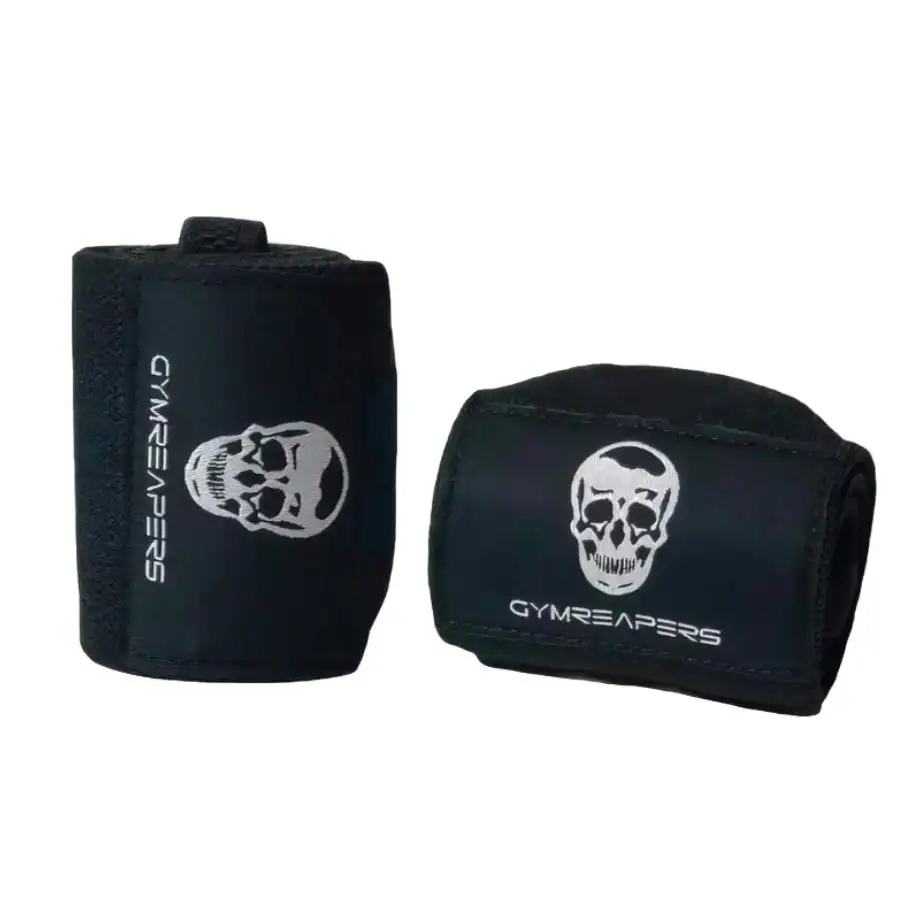
Pros
- Durable materials and construction
- IPF, IPL, and USAPL-approved
- Lifetime replacement guarantee
- Nine color options
Cons
- Not supportive enough for serious benchers
- Stiffer materials are less comfortable
The Classic Wrist Wraps from Gymreapers are excellent for benching. They feature a heavy-duty thumb loop, so you can use your thumb to anchor the wrap down before cinching it tight. I especially appreciate the 30/70 elastic-polyester blend; this is stiffer than a cotton-elastic blend. The former is what you want when trying to bench press as much weight as possible because the more rigid polyester material will provide more stiffness.
One customer said that these wraps have a lot of elasticity, which helps provide better support on heavy pushing movements because they’ll offer better support due to the amount of stretchiness in the material. Also, the three-inch width is generous and offers plenty of hand & wrist coverage for maximal support.
Gymreapers has made a serious push to get their support wear certified by well-known federations, and it shows. Their wrist wraps are IPF, IPL, and USAPL-approved, which means that if you’re competing in any of these federations, you can practice with the same gear in your training as you’ll compete with on the platform for a competitive edge.
I’m blown away by their warranty, which offers a lifetime replacement — this is practically unheard of for wear-and-tear items. The benefit is that whether they fail due to a factory defect or regular old wear and tear, you have total peace of mind about getting a replacement for free.
One commenter explained that even when they had a small issue with one of their wrist wraps, Gymreapers just sent another set. So, if you want complete peace of mind, I think these are worth it. Another reviewer mentioned that they used them all the way up to a 385-pound bench press, and they did the job. If they can hold up to a near-400-pound bench press, they can hold up to almost anything.
It’s great that they’re approved in multiple federations, but seriously strong bench pressers might not find the Gymreapers wrist wraps supportive enough. Due to their 18-inch length, these will only wrap around average-sized wrists twice instead of the three revolutions you’ll get with a 24-inch wrist wrap. Because you get one less revolution, these wraps will feel less supportive. On an elite bench press attempt, that lack of stability is not something you’ll typically want.
Compared to cotton wrist wraps, the elastic-polyester blend of the Classics is noticeably less comfortable. If you have sensitive skin or you bruise easily, you might not enjoy using these as much as you would a cotton-elastic wrist wrap like the DMOOSE Wrist Wraps.
All the above considered, we rank these 4 out of 5 stars for their durable materials and construction, their approval for the IPF, IPL, and USAPL federations, and their lifetime replacement guarantee.
Best Premium Wrist Wraps: SBD Wrist Wraps

SBD Wrist Wraps
4.5
- Material: 70% polyester/30% rubber (flexible), 56% rubber/44% polyester (stiff)
- Length: 15.7 inches (S), 23.6 inches (M), or 39.4 inches (L)
- Closure type: Velcro
- IPF-approved: Yes
Check Price
Pros
- Excellent quality and size options
- Manufactured in Great Britain
- SBD brand is world-renowned in strength sports
- IPF-approved
Cons
- Shipping fees aren’t waived
- Wrist wraps are in metric sizing
This is the second time we’ve featured the SBD Wrist Wraps in this article. Compared to the Best Wrist Wraps for Powerlifting section, we’ve included why they’re also our top choice for premium wrist wraps below.
First, the build quality of the SBD Wrist Wraps is excellent. From the extra-thick thumb loop with commercial-grade stitching to their proprietary wide elastics, these wrist wraps live up to the hype. That’s why we’ve named them twice on this list—their quality makes them worth the premium price point.
I’m impressed that they took note of the maximum allowable width from the IPF rules on wrist wrap dimensions and matched it. The 3.15-inch width means that your hands and wrists will get the most robust support on the market. But the story is far from over; SBD offers their wraps in three sizes (small, medium, and large) to fit as many lifters as possible while even catering to their wrap stiffness preferences.
Yes, that’s right — they offer two stiffnesses to their wraps: “flexible” to allow more wrist movement and “stiff” to immobilize your wrist completely. With this quality and range of choice, it’s clear that they’re the premium wrist wrap option.
Many brands source their products from developing countries because it’s cheaper. Unfortunately, these savings often come at the expense of worse workers’ rights and unsafe manufacturing processes. The SBDs are designed and manufactured in Great Britain, so you’re supporting local manufacturing and jobs, which adds to the list of reasons these are the best premium wrist wraps.
Regarding support wear, SBD is the cream of the crop. Even though “SBD” means “Squat, Bench, Deadlift”, which refers to the power lifts themselves, the quality and workmanship that backs this brand could be why many of the top athletes in powerlifting, Olympic weightlifting, and Strongman/Strongwoman decide to sport this gear.
With that in mind, it’s hard to go wrong with these wrist wraps when the SBD brand is trusted by many athletes at the top of their sport. Oh, and being approved by the most stringent powerlifting federation in the world (the IPF) is a nice touch, too.
For how well-made these are, I’m amazed at their affordability. The SBDs retail at just $42.50 and they have everything you expect in a premium wrist wrap: a sturdy yet flexible material with a secure closure system — all of which is manufactured in Great Britain. Coupled with their IPF approval, two stiffness options, and three lengths, they’re the ultimate choice for anyone who wants the best wrist wraps on the market.
Unfortunately, shipping fees are not waived. I wasn’t expecting the shipping to be free, but considering the premium price and small packaging compared to larger home gym equipment items, shipping could disappoint some shoppers. Full disclosure: I did a mock checkout with these wraps, and the 3-6 business day option with USPS was only $5.00 — nothing to get worked up about.
Lastly, these wrist wraps from SBD are all in metric sizes only. For instance, the lengths are 40, 60, and 100 centimeters for the small, medium, and large wraps — respectively. This may seem trivial, but as the premium wrist wrap option in this article, it would be great to see imperial sizes offered as well for American shoppers.
All the above considered, we rank these 4.5 out of 5 stars for their excellent quality, sizing, and stiffness options, local manufacturing, and brand trust.
Best Stiff Wrist Wraps: Gymreapers Stiff Wrist Wraps
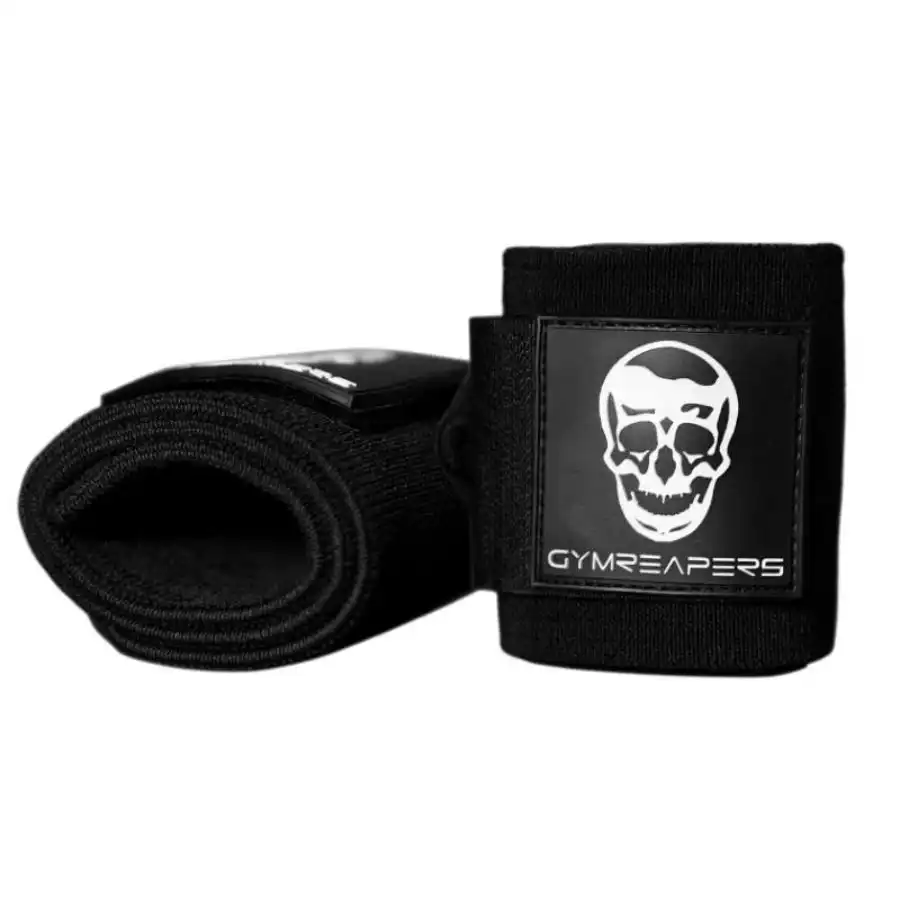
Pros
- Stiff, heavy-duty construction
- Multiple length options
- Lifetime replacement guarantee
- Three color choices
Cons
- Can be uncomfortable
- Not IPF-approved
- Higher priced at $42
These wrist wraps from Gymreapers are your ticket if you want a stiff level of wrist support. First, they’re made from more rigid cotton that’s less flexible than the Iron Bull Strength Classic Wrist Wraps. There’s also a reinforced elastic material woven into the cotton that strengthens the main body of the wraps. The end features a longer, flexible area with the Gymreapers logo in silicone so that maximal compression can be applied to your wrist. Even the thumb loop is thicker and has more durable stitching to avoid tears and maximize durability.
I’m glad there are multiple length options offered for these wrist wraps. Four sizes are available: 12-inch, 18-inch, 24-inch, and 36-inch. This means that whether you have a petite wrist, an average-sized wrist, or a larger wrist thickness, you can find an ideal fit for your wrist wraps.
However, the extra-long 36-inch wrap also allows regular lifters to size up if they want. Doing so would let you get one or two additional revolutions around your wrists with the wraps, making them even tighter and maximizing their stiffness.
Similar to the Gymreapers Classics, the stiff wraps are backed by an impressive warranty — the lifetime replacement guarantee. This warranty stipulates that you can get a free replacement for your wrist wraps throughout their life. Defect issues are also covered at no cost.
The major downside to these wraps is that they’re simply not as comfortable as standard cotton wrist wraps because of the specific cotton and reinforced elastic materials. Discomfort is just the beginning, though. In the worst-case scenario, an over-zealous wrapping job could cause bruising or minor cuts in your skin.
Honestly, I’m shocked that these aren’t IPF-approved. The Classics from Gymreapers are certified for competition use in the IPF and have less robust specs than these, so I thought for sure the same would go for their stiff wrist wraps. Their compression and material would be ideal for competitive powerlifting, warranting a submission to the IPF-approved gear application process… maybe next year?
Lastly, these wrist wraps aren’t the most affordable. They retail closely to the other most expensive pair of wrist wraps in this list, around $30 at the time of writing, but you do appear to be able to save 10 percent on your order by entering your email address into the pop-up window on their website.
All the above considered; we rank these 4 out of 5 stars for their stiff, heavy-duty construction, four length options, and lifetime replacement guarantee.
Best Budget Wrist Wraps: Harbinger Red Line Wrist Wraps
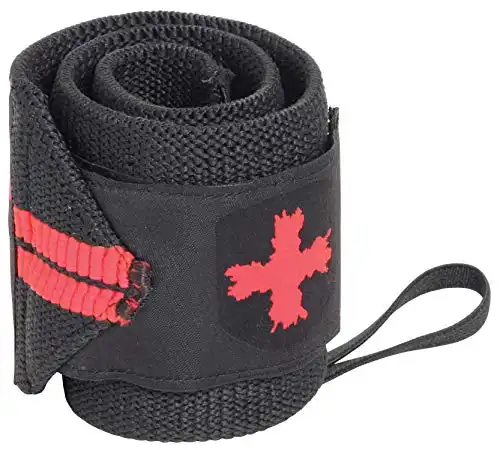
Pros
- Highly affordable support wear
- Amazon Prime perks and customer approval
- Solid wrist wrap features
- Five colors
Cons
- Construction material not listed
- Not IPF-approved
These Harbinger wrist wraps are the best budget option I found. It should come as no surprise that they’re widely affordable, roughly $16 at the time of publishing. Compared to the most expensive pair of wrist wraps on our list, the SBD Wrist Wraps, these budget-friendly ones cost you about a third of their price — before shipping fees.
Speaking of shipping fees, these wrist wraps are sold on Amazon, which means that if you’re a Prime member, you can save even more! Two-day (or faster shipping) is often available to Prime members while shopping through Amazon, giving you access to their generous and convenient return policies.
For how well-priced these are, I’m pleasantly surprised with the features they have. They have what appears to be a decent-quality thumb loop, a durable elastic body, Velcro that looks like it will work for at least a few months, and an 18-inch length that will be suitable for most weight-lifting activities.
What caught my eye on the product page was the amount of praise these wrist wraps have received from customers. Harbinger is a well-known brand that’s been in business for years, but it’s comforting to know that most customers are happy with the quality of these wrist wraps. For example, they achieved a 4.7 out of 5 stars on Amazon with over 4,400 reviews.
One Breaking Muscle staff member also saw a special notice when viewing the page that said, “Customers usually keep this item” and explained that compared to similar products, the Harbinger wrist wraps had fewer returns than average. Perhaps that’s a testament to their excellent quality.
Unfortunately, I had no luck finding their construction material on the product listing. While I wouldn’t be surprised if these were made with an extra-cheap material to cut costs even further to generate a profit, they look like a cotton-elastic blend like many wrist wraps in this list. I think it’s pretty far-fetched to expect these to be IPF-approved, considering their budget-friendly price, so don’t expect to step on a competition platform with them any time soon.
All the above considered, we rank these 3.5 out of 5 stars for their budget-friendly price, inclusion of useful wrist wrap features, and availability of Amazon perks for Prime members.
Benefits of Using Wrist Wraps for Lifting
Wrist Stability and Support
The main benefit of using wrist wraps is stability. When worn correctly around the base of your hand and wrist, the stiffness and compression from the wrist wrap material prevent your wrist from moving — similar to how a cast immobilizes an injured limb. This effect is most noticeable in free-weight pressing exercises like the barbell bench press or barbell overhead press, where they limit wrist flexion and extension even when the weight is heavy.
However, wrist wraps will continue to support your wrists even if they flex or extend under load. For example, some lifters use wrist wraps to keep the wrists extended on their low-bar back squat, holding the barbell in the correct spot across their rear delts. Despite being bent backward with hundreds of pounds pushing down on them, powerlifters continue to set world records with extended wrists while squatting — and their wraps continue to keep their wrists safe even under these extreme loads.
Additional Support After Injury
Injuries to the hand, wrist, or forearm can sometimes prevent you from holding a barbell or dumbbell correctly, even after you’ve healed. In extreme cases, even a slight deviation from a neutral wrist position under heavy weight could cause severe pain and/or further injury. In these situations, wrist wraps may provide enough wrist stability, compression, and support for you to continue to exercise. Always consult your medical doctor to ensure you can train safely after an injury.
After breaking their wrist years ago, one of our Breaking Muscle staff members finds it still bothers them when they perform the barbell overhead press, even though it’s technically healed. Using wrist wraps on their heavier sets allows them to push the movement hard without wrist pain.
Weight May Feel Lighter in Your Hands
The weight of a barbell in your hands can feel lighter or heavier depending on how tight you grip it. This is because of proprioception, which is how your body senses itself and the world around it. Proprioception is triggered by receptors in your skin, muscles, tendons, and joints that send signals to your brain. The more you squeeze the barbell, the more signals you send, and the more aware you are of the weight and body position.
When applied tightly, the compression on your forearm muscles from wrist wraps can make your fingers curl inward, making your grip stronger than usual. This is why some elite deadlifters use wrist wraps when they deadlift. They make you feel more confident and strong — so wrist wraps can provide a psychological benefit that might encourage you to lift heavier or push for more reps than you would without them.
When Should You Use Wrist Wraps?
Generally, you’ll want to wear wrist wraps on exercises where force pushes down into your wrist joint — the most common examples are below.
Pressing exercises
Bench presses and overhead presses are the most popular lifts to use wrist wraps for. During these exercises, maintaining a neutral wrist position is helpful to transfer force more efficiently into the implement you’re lifting. Wrist wraps are often used with the free-weight variations of these pressing exercises, but they can still provide noticeable benefits when used on their machine variations, too.
Back squats
Surprisingly, wrist wraps can also be an asset on back squats — particularly low-bar back squats. Since the low-bar position requires the barbell to be placed lower on your back across your rear delts, this style sometimes forces lifters to hold their wrists in extension to keep the bar in place. Unfortunately, this position can be painful with hundreds of pounds pushing downward — wrist wraps can help absorb the load and make the position painless.
Olympic lifts
You should also consider wearing wrist wraps on Olympic lifts like snatches and clean & jerks. Although the first part of each lift is a pull from the floor, both movements finish overhead in a position that will put downward pressure on your wrists. The issue is that both exercises, especially the clean and jerk, require a significant amount of wrist mobility during the initial parts of the movement. For this reason, consider using a shorter wrist wrap and/or experiment with the tightness and technique of how you put them on.
Deadlifts
As mentioned previously, some elite deadlifters use wrist wraps when they deadlift. This is because the compression on your finger-flexing muscles can cause your hand to close, which can trick you into thinking you have a stronger grip. The key is to make a fist and wrap the wrist wraps as tightly as you can.
Most of the time, you’ll find lifting straps more helpful on deadlifts than wrist wraps. However, they might be worth practicing with and using if your federation allows them to be used in competition — because wrist straps almost certainly won’t be permitted.
What to Consider When Buying Wrist Wraps
Materials and Construction
Wrist wraps are usually made of a thumb loop on one end, an elastic body, and a Velcro closure system on the other end. The thumb loop helps to secure the wrap around your wrist, while the elastic body provides support and stability for your wrist joint. The Velcro closure system allows you to adjust the tightness and fit of the wrap according to your preference and comfort.
There are different types of materials used for wrist wraps, such as a cotton-elastic blend or a tri-blend of elastic, polyester, and cotton. Cotton and elastic wraps are softer and more breathable, but they may stretch over time and lose their elasticity. Elastic, polyester, and cotton blends are more durable and resistant to stretching, but they may be less comfortable and more prone to causing skin irritation.
Another important factor to consider is the construction of the wrist wraps, especially the seams. Since wrist wraps are subjected to a lot of pulling and tension during use, they should have strong and sturdy seams that can withstand the stress. Double-stitched seams are recommended at a minimum, especially for the thumb loop, the anchor point that gets the most tension when you put on the wrist wraps. You should also check the quality of the Velcro and make sure it is not too rough or too weak.
Similar to knee sleeves, there’s a significant amount of pulling and tension involved in using wrist wraps. They should have double-stitched seams at a minimum, especially for the thumb loop, because that’s the anchor point that gets the most tension when the wrist wraps are being put on.
Length
The length of wrist wraps can range from 12 inches up to 36 inches long. Here are the most common lengths.
- Twelve inches is a good length for teenagers due to their still-developing bones and for adults with extremely small wrists. Additionally, 12-inch lengths are suitable for CrossFit because they provide lightweight support without compromising the high degree of wrist mobility needed in the sport.
- Eighteen inches can be great for those with smaller wrists and Olympic weightlifting; because of the shorter length, they won’t wrap around your wrists as many times, which can give you more mobility in your snatches and cleans while still giving some support for your jerks.
- Twenty-four inches is the sweet spot for most people because this length allows for about three wraps around the average person’s wrist, which is just right for providing a noticeable level of support.
- Thirty-six inches is starting to get excessively long. Ordinary people will find these wrap around your wrists a lot, which can add too much bulk to your wrist area. That said, some folks with large wrists may find that the 36-inch length gives enough revolutions to provide adequate support. Also, experienced powerlifters can sometimes prefer four to six wraps around their wrists than the standard two to three that 20-inch wraps will offer.
Stiffness
One of the main factors to consider when buying wrist wraps is stiffness, which depends on two things: the material and the length.
Wrist wraps with a blend of cotton, elastic, and polyester will provide more tension than those only made from cotton and elastic. This means they will support your wrists better and prevent injuries, but they will also limit your range of motion and flexibility.
Longer wraps also allow you to perform more wraps around your wrist, increasing stiffness and stability. However, too many wraps can cut off blood circulation and cause discomfort. Therefore, you should choose the stiffness level that suits your goals and preferences.
Type of Training
Different types of training will require different types of wrist wraps. Depending on your goals and preferences, choose wrist wraps that suit your specific needs. Here are some common types and the corresponding wrist wraps that may work best for them:
- General fitness: If you’re doing general fitness exercises, such as push-ups, dumbbell presses, or kettlebell swings, you won’t need heavy or stiff wrist wraps. You can opt for lighter and more flexible wrist wraps that provide enough support that you’d find in a 12-inch length.
- Powerlifting: If you’re doing powerlifting exercises, such as the back squat and bench press, you’ll need more rigid and supportive wrist wraps to handle heavy loads and prevent wrist injuries. You should opt for thicker and stiffer wrist wraps with more elasticity and less give. 24-inch is a great length or 36-inches for advanced powerlifters.
- Olympic lifting: If you’re doing Olympic lifting exercises, such as snatch, clean, or jerk, you’ll need more flexible and dynamic wrist wraps that can allow you to move your wrists freely and quickly. Opt for thinner and softer wrist wraps made from a cotton-elastic blend and are no longer than 18 inches.
- CrossFit: If you’re doing CrossFit exercises, such as thrusters, burpees, and pull-ups, you’ll need shorter and less compressive wrist wraps that can handle different movements and extended workout periods. You should opt for lightweight wrist wraps that are made from cotton and are between 12 to 18 inches long.
- Strongman/Strongwoman: If you’re doing strongman/strongwoman exercises, such as atlas stones, farmer’s walk, or log press, you’ll need durable and resilient wrist wraps that can withstand extreme pressure and abrasion. Choose stiff wrist wraps made from a tri-blend for high elasticity and low give — the 24 to 36-inch length is ideal for this sport.
Competition Approval
If you plan to compete in powerlifting meets, you may need to check if the governing bodies approve your wrist wraps for those sports. Different federations may have different rules and regulations regarding the specifications and usage of wrist wraps.
For example, the IPF (International Powerlifting Federation) is the world’s leading powerlifting federation that organizes international events like the World Powerlifting Championships. The IPF has strict rules on the size, material, design, and brand of wrist wraps that can be used in competitions. The maximum length of wrist wraps is one meter (39 inches), and the maximum width is eight centimeters (three inches). The IPF also has a list of approved brands that can be used in its competitions.
You should always check with the competition organizers before using wrist wraps to ensure they comply with their rules.
Final Thoughts
Wrist wraps are a valuable accessory for anyone who wants to improve their performance and protect their wrists from injury. They come in different sizes, colors, styles, and stiffness levels. When buying wrist wraps, you should consider the material and the length of the wrap, as they affect the tension and support the wrap provides.
Best Wrist Wraps: Side-by-Side Comparison
Best Wrist Wraps Overall

Description:
- Material: Cotton-elastic blend
- Length: 18 inches
- Closure type: Velcro
- IPF-approved: No
Best Wrist Wraps for Powerlifting

Description:
- Material: 70% polyester/30% rubber (flexible), 56% rubber/44% polyester (stiff)
- Length: 15.7 inches (S), 23.6 inches (M), or 39.4 inches (L)
- Closure type: Velcro
- IPF-approved: Yes
Best Wrist Wraps for Weightlifting

Description:
- Material: Cotton-elastic blend
- Length: 12 or 18 inches
- Closure type: Velcro
- IPF-approved: No
Best Wrist Wraps for CrossFit

Description:
- Material: Cotton-elastic-polyester blend
- Length: 12 inches
- Closure type: Velcro
- IPF-approved: No
Best Wrist Wraps for Benching

Description:
- Material: 30% Elastic and 70% Polyester blend
- Length: 18 inches
- Closure type: Velcro
- IPF-approved: Yes
Best Stiff
Wrist Wraps

Description:
- Material: Stiff cotton with reinforced elastic
- Length: 12, 18, 24, or 36 inches
- Closure type: Velcro
- IPF-approved: Yes
Best Budget Wrist Wraps

Description:
- Material: Not listed
- Length: 18 inches
- Closure type: Velcro
- IPF-approved: No
FAQs
The best brand of wrist wraps is Iron Bull Strength because their Classic Wrist Wraps have great wrist support, feature an easy-to-use Velcro closure system, and are functional for different training types.
SBD makes the best wrist wraps for powerlifting due to their IPF approval, excellent build quality and durability, and various length and stiffness options.
Most people should get wrist wraps that are 18 to 24 inches long. If you have smaller wrists or use them for Olympic weightlifting, get a 12 to 18-inch length. If you have large wrists, are an experienced powerlifter, or like Strongman/Strongwoman training, consider a 36-inch length instead.
You should only wear wrist wraps for the time it takes to complete your set. To properly support your wrist, they need to be uncomfortably tight and must be removed or loosened after your set.
The best wrist wraps for CrossFit are the 2POOD Velcro Wrist Wraps because of their lightweight support, secure and easy-adjusting tension system, and being the official wrist wraps of the NOBULL CrossFit Games.


